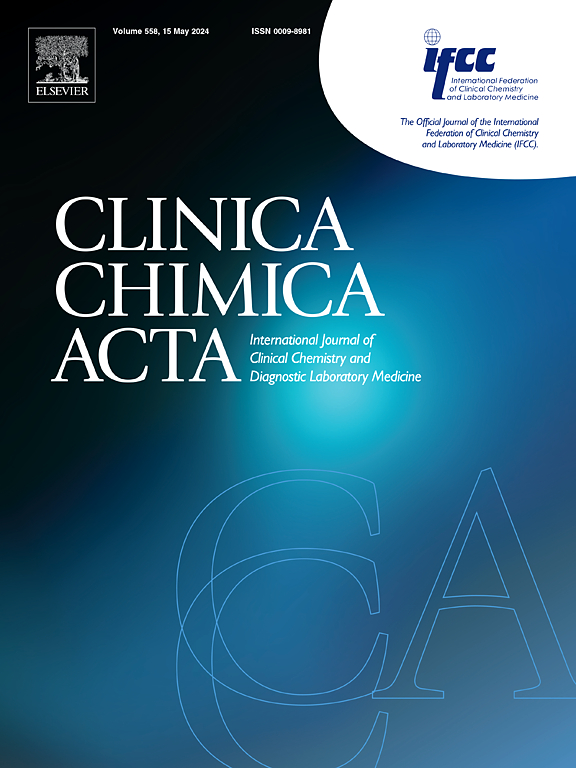Biosensors for the detection of celiac disease
IF 3.2
3区 医学
Q2 MEDICAL LABORATORY TECHNOLOGY
引用次数: 0
Abstract
Celiac disease (CeD) is an autoimmune disorder triggered by sensitivity to gluten, a protein complex found in wheat, barley, and rye. Gliadins, a component of gluten, are proteins that trigger an immune response in individuals with CeD, primarily affecting the small intestine’s inner lining. Despite a 1–1.5% prevalence, only 24% of cases are diagnosed due to non-specific symptoms. Screening is advised for high-risk groups, including first-degree relatives and type 1 diabetes patients. The accurate diagnosis of this condition and the assessment of the patient’s response to the current treatment – a lifelong gluten-free diet – necessitate using dependable, swift, sensitive, specific, uncomplicated, and affordable analytical methods. Detecting CeD biomarkers in whole blood, serum, or plasma provides a non-invasive approach that serves as an ideal initial diagnostic step. Biosensors offer a novel and alternative way for CeD detection, began emerging in 2007, and hold promise for clinical and point-of-care applications. This review explores the use of biomarker-based diagnostic approaches for CeD, with a focus on biosensors. It delves into the progress of biosensors for CeD diagnosis, identifying trends and challenges in this evolving field. Key biomarkers are highlighted, offering insights into the evolving landscape of biosensors in CeD detection.

用于检测乳糜泻的生物传感器。
乳糜泻(CeD)是一种自身免疫性疾病,由对麸质(小麦、大麦和黑麦中发现的一种蛋白质复合物)的敏感性引发。麦胶蛋白是谷蛋白的一种成分,是一种在CeD患者体内引发免疫反应的蛋白质,主要影响小肠内壁。尽管患病率为1-1.5%,但只有24%的病例是由于非特异性症状而被诊断出来的。建议对高危人群进行筛查,包括一级亲属和1型糖尿病患者。这种情况的准确诊断和评估患者对当前治疗的反应-终身无麸质饮食-需要使用可靠,快速,敏感,特异性,简单和负担得起的分析方法。在全血、血清或血浆中检测CeD生物标志物提供了一种非侵入性的方法,是理想的初始诊断步骤。生物传感器为CeD检测提供了一种新颖的替代方法,于2007年开始出现,并有望在临床和护理点应用。这篇综述探讨了基于生物标志物的诊断方法在CeD中的应用,重点是生物传感器。它深入研究了生物传感器用于CeD诊断的进展,确定了这一不断发展的领域的趋势和挑战。重点介绍了关键的生物标志物,为生物传感器在CeD检测中的发展前景提供了见解。
本文章由计算机程序翻译,如有差异,请以英文原文为准。
求助全文
约1分钟内获得全文
求助全文
来源期刊

Clinica Chimica Acta
医学-医学实验技术
CiteScore
10.10
自引率
2.00%
发文量
1268
审稿时长
23 days
期刊介绍:
The Official Journal of the International Federation of Clinical Chemistry and Laboratory Medicine (IFCC)
Clinica Chimica Acta is a high-quality journal which publishes original Research Communications in the field of clinical chemistry and laboratory medicine, defined as the diagnostic application of chemistry, biochemistry, immunochemistry, biochemical aspects of hematology, toxicology, and molecular biology to the study of human disease in body fluids and cells.
The objective of the journal is to publish novel information leading to a better understanding of biological mechanisms of human diseases, their prevention, diagnosis, and patient management. Reports of an applied clinical character are also welcome. Papers concerned with normal metabolic processes or with constituents of normal cells or body fluids, such as reports of experimental or clinical studies in animals, are only considered when they are clearly and directly relevant to human disease. Evaluation of commercial products have a low priority for publication, unless they are novel or represent a technological breakthrough. Studies dealing with effects of drugs and natural products and studies dealing with the redox status in various diseases are not within the journal''s scope. Development and evaluation of novel analytical methodologies where applicable to diagnostic clinical chemistry and laboratory medicine, including point-of-care testing, and topics on laboratory management and informatics will also be considered. Studies focused on emerging diagnostic technologies and (big) data analysis procedures including digitalization, mobile Health, and artificial Intelligence applied to Laboratory Medicine are also of interest.
 求助内容:
求助内容: 应助结果提醒方式:
应助结果提醒方式:


